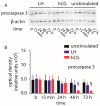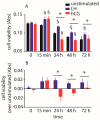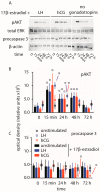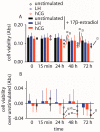Estrogen Modulates Specific Life and Death Signals Induced by LH and hCG in Human Primary Granulosa Cells In Vitro
- PMID: 28452938
- PMCID: PMC5454839
- DOI: 10.3390/ijms18050926
Estrogen Modulates Specific Life and Death Signals Induced by LH and hCG in Human Primary Granulosa Cells In Vitro
Abstract
Luteinizing hormone (LH) and human chorionic gonadotropin (hCG) are glycoprotein hormones used for assisted reproduction acting on the same receptor (LHCGR) and mediating different intracellular signaling. We evaluated the pro- and anti-apoptotic effect of 100 pM LH or hCG, in the presence or in the absence of 200 pg/mL 17β-estradiol, in long-term, serum-starved human primary granulosa cells (hGLC) and a transfected granulosa cell line overexpressing LHCGR (hGL5/LHCGR). To this purpose, phospho-extracellular-regulated kinase 1/2 (pERK1/2), protein kinase B (pAKT), cAMP-responsive element binding protein (pCREB) activation and procaspase 3 cleavage were evaluated over three days by Western blotting, along with the expression of target genes by real-time PCR and cell viability by colorimetric assay. We found that LH induced predominant pERK1/2 and pAKT activation STARD1, CCND2 and anti-apoptotic XIAP gene expression, while hCG mediated more potent CREB phosphorylation, expression of CYP19A1 and procaspase 3 cleavage than LH. Cell treatment by LH is accompanied by increased (serum-starved) cell viability, while hCG decreased the number of viable cells. The hCG-specific, pro-apoptotic effect was blocked by a physiological dose of 17β-estradiol, resulting in pAKT activation, lack of procaspase 3 cleavage and increased cell viability. These results confirm that relatively high levels of steroidogenic pathway activation are linked to pro-apoptotic signals in vitro, which may be counteracted by other factors, i.e., estrogens.
Keywords: LH; apoptosis; gonadotropins; granulosa; hCG.
Conflict of interest statement
The authors declare no conflict of interest.
Figures






Similar articles
-
Follicle-stimulating hormone potentiates the steroidogenic activity of chorionic gonadotropin and the anti-apoptotic activity of luteinizing hormone in human granulosa-lutein cells in vitro.Mol Cell Endocrinol. 2016 Feb 15;422:103-114. doi: 10.1016/j.mce.2015.12.008. Epub 2015 Dec 12. Mol Cell Endocrinol. 2016. PMID: 26690776
-
LH and hCG action on the same receptor results in quantitatively and qualitatively different intracellular signalling.PLoS One. 2012;7(10):e46682. doi: 10.1371/journal.pone.0046682. Epub 2012 Oct 5. PLoS One. 2012. PMID: 23071612 Free PMC article.
-
Participation of mitogen-activated protein kinase in luteinizing hormone-induced differential regulation of steroidogenesis and steroidogenic gene expression in mural and cumulus granulosa cells of mouse preovulatory follicles.Biol Reprod. 2006 Dec;75(6):859-67. doi: 10.1095/biolreprod.106.052613. Epub 2006 Aug 30. Biol Reprod. 2006. PMID: 16943367
-
'Spare' Luteinizing Hormone Receptors: Facts and Fiction.Trends Endocrinol Metab. 2018 Apr;29(4):208-217. doi: 10.1016/j.tem.2018.01.007. Epub 2018 Feb 9. Trends Endocrinol Metab. 2018. PMID: 29429918 Review.
-
Pleiotropic anti-apoptotic activity of glucocorticoids in ovarian follicular cells.Biochem Pharmacol. 2003 Oct 15;66(8):1393-401. doi: 10.1016/s0006-2952(03)00489-1. Biochem Pharmacol. 2003. PMID: 14555213 Review.
Cited by
-
miR-450-5p and miR-202-5p Synergistically Regulate Follicle Development in Black Goat.Int J Mol Sci. 2022 Dec 26;24(1):401. doi: 10.3390/ijms24010401. Int J Mol Sci. 2022. PMID: 36613843 Free PMC article.
-
Identification of Functional Single Nucleotide Polymorphisms in Porcine HSD17B14 Gene Associated with Estrus Behavior Difference between Large White and Mi Gilts.Biomolecules. 2020 Nov 12;10(11):1545. doi: 10.3390/biom10111545. Biomolecules. 2020. PMID: 33198360 Free PMC article.
-
Identification of Key Receptor Residues Discriminating Human Chorionic Gonadotropin (hCG)- and Luteinizing Hormone (LH)-Specific Signaling.Int J Mol Sci. 2020 Dec 25;22(1):151. doi: 10.3390/ijms22010151. Int J Mol Sci. 2020. PMID: 33375708 Free PMC article.
-
Ferroptosis precedes apoptosis to facilitate specific death signalling by fatty acids.Proc Biol Sci. 2023 Oct 25;290(2009):20231327. doi: 10.1098/rspb.2023.1327. Epub 2023 Oct 25. Proc Biol Sci. 2023. PMID: 37876198 Free PMC article.
-
Membrane Estrogen Receptor (GPER) and Follicle-Stimulating Hormone Receptor (FSHR) Heteromeric Complexes Promote Human Ovarian Follicle Survival.iScience. 2020 Nov 18;23(12):101812. doi: 10.1016/j.isci.2020.101812. eCollection 2020 Dec 18. iScience. 2020. PMID: 33299978 Free PMC article.
References
MeSH terms
Substances
LinkOut - more resources
Full Text Sources
Other Literature Sources
Medical

